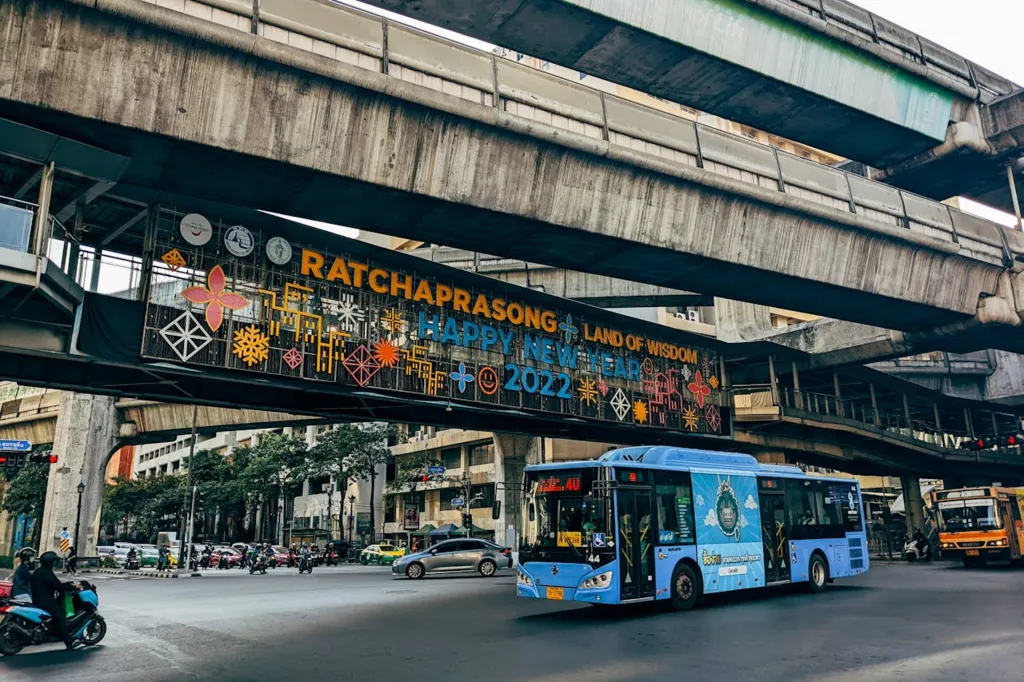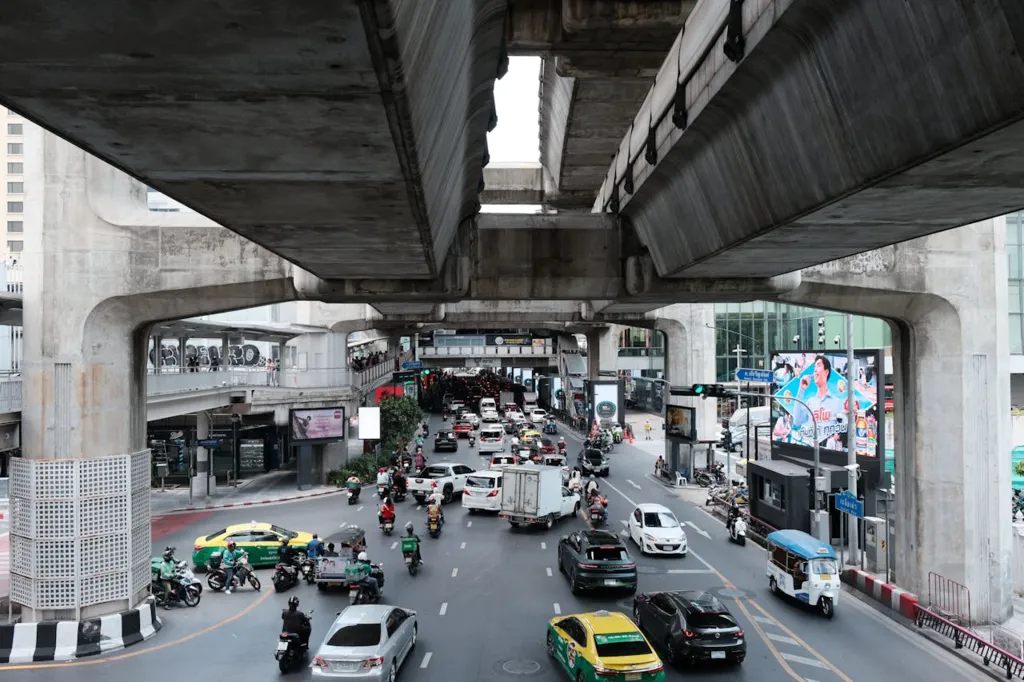Thailand's embrace of electric buses (e-buses) is not a simple trend but a cornerstone of a deliberate, multi-faceted national strategy. This analysis indicates that the country's rapid adoption of e-buses is a nexus of ambitious government policies, compelling economic logic, and a pressing need to solve chronic urban problems. At its core, the revolution is orchestrated by a vertically integrated policy framework, where macro-level climate goals, such as achieving carbon neutrality by 2050, are operationalized through specific, high-impact programs like the Bangkok Mass Transit Authority (BMTA) leasing project and the national EV 3.5 incentive package.
While Thailand possesses a formidable legacy as the "Detroit of the East," its transition to a true electric vehicle (EV) export powerhouse is fraught with complex challenges. The established automotive ecosystem, traditionally centered on internal combustion engine (ICE) technology, does not seamlessly translate to the EV value chain, revealing significant gaps in advanced component manufacturing and a reliance on foreign partners for core technologies. Furthermore, the market is being reshaped by intense competition and price wars driven by the influx of Chinese manufacturers, which is placing considerable pressure on legacy players. The success of the e-bus revolution and its potential to serve as a model for broader EV industrialization hinges on the government's ability to maintain a consistent, long-term policy vision that compels deep local integration while addressing fundamental market deficiencies, such as a lack of research and development capabilities in critical areas.
1. Strategic Foundations: The Drivers of Thailand's E-Bus Revolution

Thailand's rapid shift toward electric buses is a strategic response to a confluence of national, economic, and urban pressures. It is an intricate, multi-layered process driven by a cohesive national vision that extends from high-level climate commitments down to specific public procurement decisions.
1.1 Policy Mandates and National Ambitions
The foundation of Thailand's e-bus transformation rests on clear policy mandates designed to position the country as a regional leader in sustainable mobility. The overarching national goal, outlined in the "30@30" policy, is to ensure that at least 30% of total vehicle production by 2030 consists of Zero Emission Vehicles (ZEVs). This initiative is a core component of Thailand's broader commitment to a low-carbon society, aiming for carbon neutrality by 2050 and net zero emissions by 2065.
This national vision is not abstract; it is translated into concrete, actionable programs that directly affect the e-bus sector. The Cabinet's approval of a comprehensive electric bus leasing program for the BMTA is a prime example of this vertical integration. This transformative, seven-year initiative will see the BMTA lease 1,520 air-conditioned electric buses, directly modernizing the capital’s aging fleet while aligning with the nation’s long-term environmental and mobility goals. This approach signals a deliberate shift away from earlier plans that focused on natural gas-powered buses and provides a consistent policy signal to the market, reducing regulatory uncertainty and de-risking long-term capital investments for both domestic and international players.
1.2 Economic and Operational Imperatives
Beyond environmental directives, the transition to e-buses is a rational economic decision driven by operational efficiency and cost reduction. The data suggests that e-buses offer a compelling business case for large-scale fleet operators. The BMTA, for instance, anticipates a "threefold reduction" in operational costs compared to its existing fleet of diesel and natural gas vehicles (NGVs). This significant cost advantage is a result of several factors, including lower charging costs relative to fuel costs for ICEVs, which is a major motivator for fleet operators. Furthermore, e-buses have substantially lower maintenance requirements, as they have fewer moving parts and do not require regular oil changes, which helps to control operational budgets.
The financial viability of the BMTA project is clearly demonstrated by its projected revenue generation of approximately THB 52.65 billion over its lifecycle, yielding an estimated net profit of THB 19.85 billion. This strong financial performance underscores that the transition is not merely a "green" initiative but a strategic financial overhaul for state enterprises. The leasing model is particularly strategic in this context, as it relieves the BMTA of the substantial capital expenditure and maintenance burdens associated with vehicle ownership, transforming what would be a high-risk, capital-intensive investment into a more predictable service-based contract. This strong and stable business case for public and private fleet operators creates a predictable demand signal that is highly attractive to manufacturers, which is a key distinction from the more volatile consumer market for electric vehicles.
1.3 The Urban Mobility Catalyst

The e-bus revolution serves as a direct and necessary solution to critical urban problems that have long plagued major Thai cities. Chronic traffic congestion and severe air pollution, particularly from fine particulate matter (PM2.5), are major public health and economic burdens. The economic cost of traffic congestion in Bangkok alone is estimated to be approximately THB 11 billion per year. E-buses are positioned as a direct remedy, as they produce zero tailpipe emissions, helping to reduce harmful PM2.5 and other pollutants. In a direct response to this crisis, the government has even offered temporary free public transit, including buses, to encourage a shift away from private vehicles and mitigate PM2.5 levels.
The benefits extend beyond air quality. E-buses are also significantly quieter than their diesel counterparts, operating at 60-70 dB compared to over 80 dB for diesel buses. This reduction in noise pollution directly improves the quality of life for residents along bus routes. The BMTA's strategic goal to make the public bus system the "main network for urban travel" is a direct acknowledgment that modernizing the fleet with cleaner, more efficient vehicles is essential for addressing the economic and social burdens of congestion and pollution. The BMTA and Phuket e-bus projects explicitly list "solving air pollution" and "reducing traffic congestion" as primary objectives, demonstrating that the e-bus transition is not a "nice-to-have" but a strategic necessity for the long-term health and economic viability of Thailand's urban centers.
2. Cultivating Local Strength: The Domestic EV Manufacturing Ecosystem
2.1 Policy-Driven Localization
The government is employing a powerful "carrot-and-stick" approach to compel foreign and local companies to invest in domestic manufacturing capabilities. The BMTA's landmark leasing program, for instance, stipulates that a minimum of 40% of the components for the new fleet must be sourced domestically. This requirement is intended to actively "strengthen Thailand's EV ecosystem" by creating business opportunities for local manufacturers.
Similarly, the national EV 3.5 incentive package, which runs from 2024 to 2027, ties subsidies and tax benefits to strict domestic production offset conditions. As shown in the table below, for every one Completely Built-Up (CBU) unit a company imports during 2024-2025, it must produce two or three vehicles domestically by 2026 or 2027, respectively. This direct, quantifiable mandate for localization is arguably the most critical policy lever in the entire strategy. It ensures that the economic benefits, including job creation, technology transfer, and industrial development, remain within Thailand. This approach is designed to prevent the country from becoming a mere consumption market for imported vehicles.
| Import Period | Requirement |
|---|---|
| 2024-2025 | For every 1 CBU unit imported, must produce 2 domestically by 2026 |
| 2024-2025 | For every 1 CBU unit imported, must produce 3 domestically by 2027 |
2.2 Key Players in the E-Bus Supply Chain
While the passenger car market is currently dominated by a flood of Chinese brands and intense price competition, the commercial e-bus sector is seeing the rise of strong domestic players. Companies like NEX Point have emerged as central figures in this transformation. NEX, a Thai company, manufactures and assembles commercial electric vehicles, including buses, with a production capacity of up to 9,000 units per year.
A clear and effective model for the industry's future is demonstrated by the close partnership between NEX and Thai Smile Bus, a major private fleet operator in Bangkok. Thai Smile Bus has been awarded a contract for 71 of 77 e-bus routes in the Bangkok Metropolitan Region and has set an ambitious goal of expanding its fleet to 3,100 e-buses. This B2B model provides a more stable and predictable demand signal than the consumer market, allowing local manufacturers to scale production and refine their capabilities without being exposed to the volatility of individual consumer purchases. The success of this collaboration indicates a viable strategic niche that local companies can exploit to build a strong industrial base.
2.3 Strengths and Gaps in the Value Chain
Thailand's position as a global automotive hub provides a strong foundation for its EV ambitions. The country is the 10th largest automotive manufacturer in the world and the largest in Southeast Asia, with a robust ecosystem of over 2,200 auto parts suppliers and a skilled workforce. This legacy and a history of attracting significant foreign direct investment (FDI) from global automakers give Thailand a considerable head start in the race to become an EV hub.
However, this legacy is also a source of vulnerability. The existing ICE-centric supply chain, built on engines and transmissions, does not translate directly to EV components. A significant weakness is the lack of maturity in designing and manufacturing core EV parts like circuit diagrams, control units, and advanced batteries. The local industry still relies heavily on overseas partners for these advanced electric mobility solutions. The influx of Chinese EV manufacturers is creating intense competitive pressure and price wars, which is placing strain on legacy players and even causing some to announce production cuts. The government's localization mandates are an attempt to bridge this technological gap, but the challenges are significant and require substantial investment in new capabilities.
3. The Urban Impact: Solving Urban Mobility and Environmental Crises

3.1 Addressing Air Quality and Noise Pollution
A central objective of the e-bus transition is the direct reduction of pollution. E-buses are heralded as a direct solution to the country’s severe PM2.5 and air pollution problems, particularly in densely populated cities. Unlike conventional vehicles, e-buses produce zero tailpipe emissions, helping to significantly improve air quality. The Bangkok E-Bus Programme, a collaborative effort with Switzerland, is a prime example of this impact, with a stated aim to avoid around 500,000 tonnes of carbon dioxide (CO2) emissions by 2030.
The benefits extend to the sonic environment as well. Conventional diesel buses generate noise levels exceeding 80 dB, creating a constant din in urban environments. By contrast, e-buses operate at a much quieter 60-70 dB, which helps to reduce noise pollution and improves the overall quality of life for residents along their routes. The reduction of both air and noise pollution addresses critical public health concerns, reinforcing the idea that the e-bus transition is a strategic necessity for the long-term health and well-being of urban populations.
3.2 Enhancing Public Transit Efficiency and Accessibility
The adoption of e-buses is a key component of a broader strategy to modernize and enhance public transportation. E-buses are modernizing the capital's aging fleet, which has historically struggled with inefficiency and reliability. Vehicles in the new fleet, such as those in Phuket's project, are equipped with advanced features like GPS tracking, USB chargers, and CCTV cameras. These technological upgrades are designed to enhance the passenger experience and improve service reliability, which are crucial for attracting more riders and shifting the urban populace away from private vehicles.
The BMTA's goal is to make the public bus system the "main network for urban travel," which is a strategic effort to regain its position as the backbone of Bangkok's public transport system. The focus on providing a cleaner, more comfortable, and more reliable ride is a direct response to long-standing public complaints and a prerequisite for alleviating chronic traffic congestion, a major economic and social burden.
3.3 Financial Viability for Public and Private Operators
The financial structure of the e-bus projects is as revolutionary as the technology itself. The BMTA leasing program is structured to be financially self-sustaining and profitable, with a projected net profit of THB 19.85 billion over its lifespan. The leasing model itself is a strategic financial tool, as it relieves the public transport authority of the significant capital expenditure and maintenance liabilities associated with vehicle ownership. This de-risking of capital is a critical enabler of the rapid fleet conversion.
Private operators are also finding the model financially sound. The success of Thai Smile Bus in rapidly expanding its fleet demonstrates that the e-bus business model is profitable for private companies as well. The economic success of these projects sends a powerful signal to the global investment community that Thailand's e-bus market is a profitable, low-risk, and sustainable investment opportunity, further attracting foreign direct investment (FDI) into the sector.
4. Navigating the Regulatory and Financial Landscape
4.1 The Evolution of EV Incentives
The government's incentive strategy has evolved from the initial BEV 3.0 package (2022-2025) to the more mature BEV 3.5 package (2024-2027). The policy framework provides a complex, tiered system of subsidies, import duty reductions, and excise tax cuts that are highest in the initial years and then gradually decline. This phased reduction in subsidies is a deliberate signal from the government that the market must eventually become self-sustaining and not reliant on state handouts.
The table below provides a detailed breakdown of the subsidies and tax benefits under the BEV 3.5 policy, demonstrating how incentives vary based on vehicle type, price, and battery capacity.
| Vehicle Type | Retail Price & Battery (kWh) | Subsidy (THB) per Unit | Import Duty Reduction | Excise Tax |
|---|---|---|---|---|
| Passenger Car | ≤ THB 2M & ≥ 50 kWh | 2024: 100,000 / 2025: 75,000 / 2026-27 (domestic): 50,000 | Up to 40% (2024-25) | 2% (from 8%) |
| Passenger Car | ≤ THB 2M & ≥ 10 kWh to < 50 kWh | 2024: 50,000 / 2025: 35,000 / 2026-27 (domestic): 25,000 | Up to 40% (2024-25) | 2% (from 8%) |
| Passenger Car | > THB 2M to ≤ THB 7M & ≥ 50 kWh | No subsidy | Normal rates | 2% (from 8%) |
| Pickup Truck | ≤ THB 2M & ≥ 50 kWh | 100,000 (domestic only) | Normal rates | 0% (2024-25), 2% (2026-27) |
| Motorcycle | ≤ THB 150K & ≥ 3 kWh | 10,000 (domestic only) | Normal rates | 1% (from 5%) |
Note: Data points consolidated from various sources.
4.2 Production Offset Mandates and Their Implications
A critical and highly strategic element of the EV 3.5 policy is the domestic production offset mandate. This policy requires that for every Completely Built-Up (CBU) unit imported during the 2024-2025 window, manufacturers must produce 2-3 vehicles domestically by 2026-2027. This requirement is intended to prevent market flooding with cheap imports and ensure that Thailand secures long-term benefits from local manufacturing, technology transfer, and job creation.
While this policy is a powerful driver for localization, it also presents risks. The compressed timeline places immense pressure on companies to establish local manufacturing capacity rapidly, which may strain resources and deter some smaller or less committed firms. Success will depend on the government’s ability to enforce these mandates consistently while also providing supportive infrastructure and R&D incentives to ensure that the localized industry is competitive on a global scale.
4.3 Strategic Risk Management
The success of Thailand’s e-bus strategy is contingent upon consistent and long-term policy execution. The transition from ICE to EV is not merely a technological shift but a comprehensive transformation of the entire industrial ecosystem, requiring careful coordination across multiple sectors. Potential risks include regulatory inconsistencies, insufficient charging infrastructure, and dependency on foreign suppliers for critical EV components like batteries and control systems. Additionally, intense global competition, especially from China, creates pressure on local manufacturers and risks destabilizing the domestic market through price wars.
To mitigate these risks, Thailand must adopt a holistic, forward-looking approach that includes significant investments in domestic R&D, workforce upskilling, and strategic partnerships with global technology leaders. Long-term success will depend on balancing the immediate need to scale adoption with the parallel imperative to build deep, sustainable local capabilities.
5. Future Outlook: Thailand’s Position in the Global EV Landscape
Thailand’s success in deploying e-buses offers more than just a local solution; it provides a replicable model for broader EV industrialization and urban modernization. The government’s decisive policies, combined with the financial viability of the leasing model and the clear public health and environmental benefits, demonstrate that EV adoption can be accelerated at scale when supported by coherent and integrated strategies.
Read Also: Thailand Automotive Industry Trends are Shifting to EV Dominance
However, the long-term viability of Thailand’s position as a global EV hub depends on its ability to overcome significant structural challenges. These include the need to build advanced component manufacturing capabilities, develop domestic R&D capacity, and maintain competitiveness in the face of intense Chinese competition. Success in these areas will determine whether Thailand can move beyond being an assembly hub to becoming a true leader in EV technology and exports.
In conclusion, Thailand’s e-bus revolution is not an isolated initiative but a strategic cornerstone of the country’s broader ambitions in the EV sector. By addressing urban challenges, stimulating local industry, and positioning itself as a global EV player, Thailand is charting a path that could serve as a model for other emerging economies. The transition is fraught with risks, but if executed with consistency and vision, it holds the potential to transform not only Thailand’s automotive industry but also its urban landscape and global economic standing.







